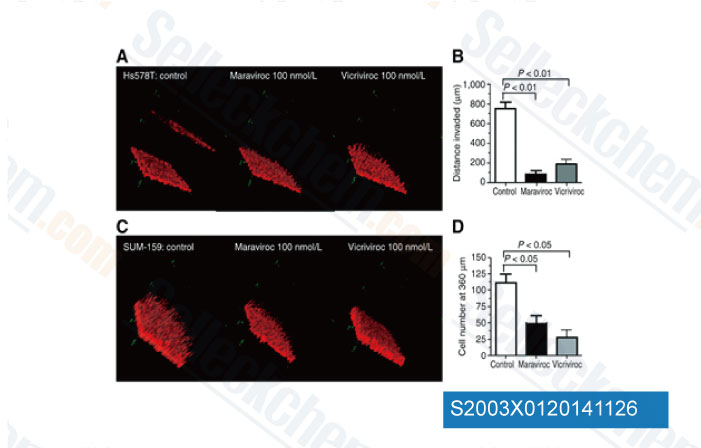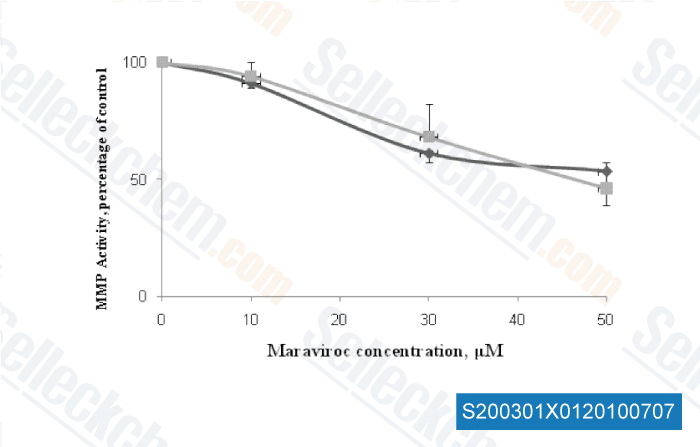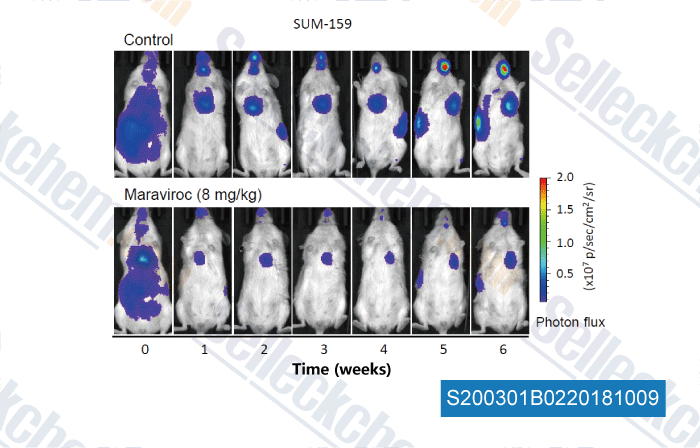|
Toll Free: (877) 796-6397 -- USA and Canada only -- |
Fax: +1-832-582-8590 Orders: +1-832-582-8158 |
Tech Support: +1-832-582-8158 Ext:3 Please provide your Order Number in the email. |
Technical Data
| Formula | C29H41F2N5O |
|||
| Molecular Weight | 513.67 | CAS No. | 376348-65-1 | |
| Solubility (25°C)* | In vitro | DMSO | 100 mg/mL (194.67 mM) | |
| Ethanol | 100 mg/mL (194.67 mM) | |||
| Water | Insoluble | |||
|
* <1 mg/ml means slightly soluble or insoluble. * Please note that Selleck tests the solubility of all compounds in-house, and the actual solubility may differ slightly from published values. This is normal and is due to slight batch-to-batch variations. * Room temperature shipping (Stability testing shows this product can be shipped without any cooling measures.) |
||||
Preparing Stock Solutions
Biological Activity
| Description | Maraviroc is a CCR5 antagonist for MIP-1α, MIP-1β and RANTES with IC50 of 3.3 nM, 7.2 nM and 5.2 nM in cell-free assays, respectively. Maraviroc is used in the treatment of HIV infection. | ||||||||
|---|---|---|---|---|---|---|---|---|---|
| Targets |
|
||||||||
| In vitro | Maraviroc inhibits MIP-1β-stimulated γ-S-GTP binding to HEK-293 cell membranes, indicating its ability to inhibit chemokine-dependent stimulation of GDP-GTP exchange at the CCR5/G protein complex. Maraviroc also inhibits the downstream event of chemokine-induced intracellular calcium redistribution, with IC50s ranging from 7 to 30 nM obtained against MIP-1β, MIP-1α and RANTES. In the same experiments, Maraviroc does not trigger release of intracellular calcium at concentrations up to 10 μM, indicating that it is devoid of CCR5 agonist activity. Consistent with this, Maraviroc fails to induce CCR5 internalization. Maraviroc is active at low nanomolar concentrations against HIV-1 Ba-L. Maraviroc inhibits all 200 pseudotyped viruses with a geometric mean IC90 of 13.7 nM. [1] At concentrations >1000 times the 50% inhibitory concentration, maraviroc did not inhibit other chemokine receptors (CCR1, 2, 3, 4, 7, and 8; CXCR1 and 2) to a clinically relevant degree[3]. |
||||||||
| In vivo | The half-life values of Maraviroc are 0.9 hour in the rat and 2.3 hours in the dog. Following oral administration (2 mg/kg) to the dog, the Cmax (256 ng/ml) occurred 1.5 hours post-dose, and the bioavailability is 40%. For the rat, approximately 30% of the administered dose is absorbed from the intestinal tract. [1] Female RAG-hu mice are challenged vaginally with HIV-1 an hour after intravaginal application of the Maraviroc gel. Maraviroc gel treated mice are fully protected against vaginal HIV-1 challenge in contrast to placebo gel treated mice which all became infected. Vaginal administration of Maraviroc fully protects mice against HIV-1 vaginal challenge. While there is a clear pattern of CD4 T cell decline in placebo-gel treated and viral challenged mice, their levels are stable in mice receiving Maraviroc gel. [2] |
Protocol (from reference)
| Kinase Assay: |
|
|---|---|
| Cell Assay: |
|
| Animal Study: |
|
References
|
Customer Product Validation

-
Data from [Cancer Res, 2012, 72(15), 3839-50]

-
, 2010, Dr. Johanna Weiss of University Hospital Heidelberg

-
Data from [Data independently produced by , , Clin Cancer Res, 2018, 78(7):1657-1671]

-
Data from [Data independently produced by , , Cancer Res, 2018, 78(7):1657-1671]
Selleck's Maraviroc has been cited by 48 publications
| Microglial-to-neuronal CCR5 signaling regulates autophagy in neurodegeneration [ Neuron, 2023, S0896-6273(23)00268-4] | PubMed: 37105172 |
| CCL5/CCR5-mediated peripheral inflammation exacerbates blood‒brain barrier disruption after intracerebral hemorrhage in mice [ J Transl Med, 2023, 21(1):196] | PubMed: 36918921 |
| Maraviroc promotes recovery from traumatic brain injury in mice by suppression of neuroinflammation and activation of neurotoxic reactive astrocytes [ Neural Regen Res, 2023, 18(1):141-149] | PubMed: 35799534 |
| Acute antagonism in three-drug combinations for vaginal HIV prevention in humanized mice [ Sci Rep, 2023, 13(1):4594] | PubMed: 36944714 |
| Revealing viral and cellular dynamics of HIV-1 at the single-cell level during early treatment periods [ Cell Rep Methods, 2023, 3(6):100485] | PubMed: 37426753 |
| Cancer-associated fibroblasts facilitate premetastatic niche formation through lncRNA SNHG5-mediated angiogenesis and vascular permeability in breast cancer [ Theranostics, 2022, 12(17):7351-7370] | PubMed: 36438499 |
| Tumor bud-derived CCL5 recruits fibroblasts and promotes colorectal cancer progression via CCR5-SLC25A24 signaling [ J Exp Clin Cancer Res, 2022, 41(1):81] | PubMed: 35241150 |
| The analgesic properties of Yu-Xue-Bi tablets in the inflammatory pain mice: By the inhibition of CCL3-mediated macrophage transmigration into the spinal cord [ J Ethnopharmacol, 2022, 289:115051] | PubMed: 35101573 |
| Imatinib Mesylate Exerted Antitumor Effect by Promoting Infiltration of Effector T Cells in Tumor [ Biol Pharm Bull, 2022, 45(1):34-41] | PubMed: 34980779 |
| Pericytes augment glioblastoma cell resistance to temozolomide through CCL5-CCR5 paracrine signaling [ Cell Res, 2021, 10.1038/s41422-021-00528-3] | PubMed: 34239070 |
RETURN POLICY
Selleck Chemical’s Unconditional Return Policy ensures a smooth online shopping experience for our customers. If you are in any way unsatisfied with your purchase, you may return any item(s) within 7 days of receiving it. In the event of product quality issues, either protocol related or product related problems, you may return any item(s) within 365 days from the original purchase date. Please follow the instructions below when returning products.
SHIPPING AND STORAGE
Selleck products are transported at room temperature. If you receive the product at room temperature, please rest assured, the Selleck Quality Inspection Department has conducted experiments to verify that the normal temperature placement of one month will not affect the biological activity of powder products. After collecting, please store the product according to the requirements described in the datasheet. Most Selleck products are stable under the recommended conditions.
NOT FOR HUMAN, VETERINARY DIAGNOSTIC OR THERAPEUTIC USE.
